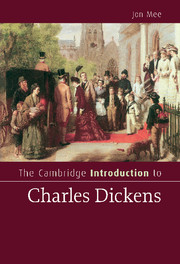Book contents
- Frontmatter
- Contents
- List of illustrations
- Preface
- Chronology
- List of abbreviations
- 1 Dickens the entertainer: ‘People must be amuthed’
- 2 Dickens and language: ‘What I meantersay’
- 3 Dickens and the city: ‘Animate London … inanimate London’
- 4 Dickens, gender, and domesticity: ‘Be it ever … so ghastly … there's no place like it’
- 5 Adapting Dickens: ‘He do the police in different voices’
- Afterword: Dickens's world
- Notes
- Further reading
- Index
- Cambridge Introductions to …
2 - Dickens and language: ‘What I meantersay’
Published online by Cambridge University Press: 05 August 2012
- Frontmatter
- Contents
- List of illustrations
- Preface
- Chronology
- List of abbreviations
- 1 Dickens the entertainer: ‘People must be amuthed’
- 2 Dickens and language: ‘What I meantersay’
- 3 Dickens and the city: ‘Animate London … inanimate London’
- 4 Dickens, gender, and domesticity: ‘Be it ever … so ghastly … there's no place like it’
- 5 Adapting Dickens: ‘He do the police in different voices’
- Afterword: Dickens's world
- Notes
- Further reading
- Index
- Cambridge Introductions to …
Summary
Looking back on his childhood, Pip struggles, even with the benefit of hindsight, to find a word to fit the discomfiture caused by his experiences in Satis House: ‘I cannot hit upon the right name for the smart – God knows what its name was’ (GE 1: 8, 62). The sense of ‘the smart without a name’ (GE 1: 8, 63) runs through the novels, intensifying in the later ones, increasingly suggestive of a gap between the profuse linguistic creativity of Dickens himself, on the one hand, and the constant feeling that the right word still cannot be found, on the other. The world of the novels is increasingly one where the characters struggle to make sense of what happens to them, where the constituted authorities of the law courts and the police can't easily find out the truth, and where society itself threatens to collapse into the gaps between words, ideas, and things. Pip early on speaks of his ‘dread of not being understood’ (GE 1: 9, 65). This chapter looks at this dreadful unease, which intensifies in the later novels such as Great Expectations, but also shadows and perhaps even fuels the energies of the earlier ones, driving them forward in pursuit of a way of describing the worlds they are constantly bringing into new life. The ‘old practice of hanging out a sign’, as Dickens puts it in Barnaby Rudge (16, 138), never quite seems adequate to communicate the full story of what is being signified.
- Type
- Chapter
- Information
- The Cambridge Introduction to Charles Dickens , pp. 20 - 42Publisher: Cambridge University PressPrint publication year: 2010



